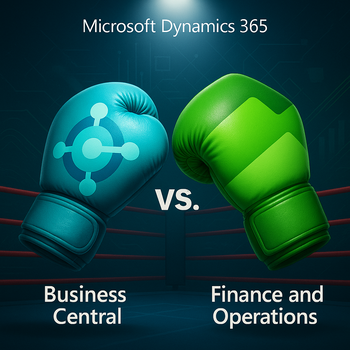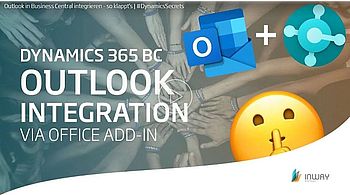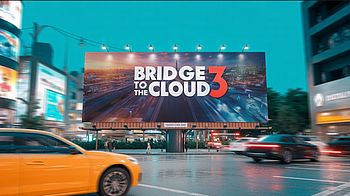Dynamics 365 Finance and Supply Chain Management compared to Dynamics 365 Business Central
Share:
Companies considering the introduction of a new ERP system regularly encounter the same questions at Microsoft:
- Is Dynamics 365 Business Central too small, or are Dynamics 365 Finance & Dynamics 365 Supply Chain Management too large?
- Is the range of functions offered by Business Central sufficient for us, or do we need more?
- Is Finance & Supply Chain Management oversized, or is it wise to consider the extensive functions for the future?
- Or, more generally: Which of the two systems is better – for us and our requirements?
We have often heard these and similar questions during customer meetings, presentations, or at events. To give a brief initial answer, we usually say:
- Business Central is the ERP solution for small and medium-sized businesses.
- Finance & Supply Chain Management is the ERP solution for large and international companies.
That is true, as far as it goes. But this is only the first part of the answer. Choosing the right ERP system is not that quick and easy. It is not just a matter of company size, number of employees, or process complexity. Business Central or Dynamics 365 Finance & Supply Chain Management is not simply a question of large versus small. It is a duel between equals, decided by many detailed questions.
What this ERP comparison is really about...
The challenge is therefore not to find the “better” or “stronger” system; the real question is which system better meets the individual requirements of your company.
In this blog post, we compare both ERP systems neutrally, focusing on their functions and requirements.
As a Microsoft Dynamics 365 partner with specialists in both Business Central and Finance & Supply Chain Management, we provide you with a valuable basis for your decision.
Our comparison covers the most important functions and topics:
1. Intercompany processes
2. International growth
3. The purchasing and finance modules
4. The production, quality management, and project modules
5. Outlook and Microsoft 365 integration
6. Implementation and go-live
In addition, let's take a look at the criteria:
7. Company size
8. Cost of the ERP system
9. Industry solution
Note
We have often compared both ERP systems on our blog.
- Business Central Vs. Finance & Supply Chain Management
- Business Central or Finance & Supply Chain Management? A checklist
- Dynamics 365 Finance or Dynamics 365 Business Central for your financial accounting
Unlike in our previous comparisons, this time we are not starting with the points where both systems are convincing, or where opinions may be divided, but with specific functions and real knockout criteria.
That's why we're diving right in with requirements that, if they apply to your needs, will force you to make a clear decision immediately. We'll start with one of the most important differences of all: intercompany processes.
1. Intercompany processes
Does your company need intercompany processes and workflows across multiple locations? Then your choice will most likely be Finance & Supply Chain Management.
This is because intercompany processes—i.e., processes between legally independent companies within a group or group of companies—are only possible with Microsoft's large ERP system Finance and Supply Chain Management.
Business Central – like Finance & Supply Chain Management – is “multi-client capable.”
However, important processes such as
- cross-client payments,
- cross-client financial postings, and
- cross-client project postings
- are only available in Finance & Supply Chain Management.
Conclusion: Intercompany processes:
If intercompany postings, intra-group allocations, intercompany purchases/sales, or the internal billing of services are important functions and requirements for you, then the question of which Microsoft ERP system to use has already been decided. This is because the large ERP system is the clear winner here. In this case, you don't even need to read any further; you can order Finance and Supply Chain Management right away.
2. International growth
A comparison based on the criterion of international growth also reveals a clear favorite: Finance & Supply Chain Management.
If you are aiming for Europe-wide or even global growth with your product or service and are already planning or maintaining branches and locations abroad, Finance & Supply Chain Management allows you to map all country-specific requirements in a single application. There is no easier or more convenient way to map international growth.
It's not quite as simple with Business Central. Here, you have to purchase and install a separate country-specific application for each country. Only the DACH region is combined in one solution package. Business Central is therefore designed for national growth (DACH) plus growth in a few additional countries. Each new country you add means you have to purchase and deploy another application. This approach can quickly become costly and slow down international growth.
Conclusion: International growth
If your growth is concentrated in the DACH region and a manageable number of other countries, you are well positioned with both ERP systems. If you consider the whole of Europe or the whole world as potential markets for your product/service, the finance and supply chain management of the smaller ERP solution Business Central is superior in this respect.
3. The Purchasing and Finance modules
Both Business Central and Finance & Supply Chain Management offer powerful purchasing and finance functions—albeit with differences in depth and scalability.
Business Central offers a very solid foundation here:
- Standard functions for accounts payable and accounts receivable accounting
- Management of purchase orders and invoices
- Approval workflows in purchasing
- Budget management and reporting
These functions are usually perfectly adequate for small and medium-sized enterprises.
Finance & Supply Chain Management, on the other hand, goes beyond these standard processes and offers:
- Group-wide financial accounting with intercompany reconciliations and consolidations
- Advanced functions such as credit management, cost accounting, treasury, and cash management
- Automated processes in purchasing and procurement, e.g., via central purchasing catalogs, supplier portals, and tendering procedures
- Strong support for complex compliance and tax requirements in different countries
Conclusion: The Purchasing and Finance modules
Both systems are a good choice for companies that need a lean and clear finance and purchasing module. However, companies that value group-wide financial processes, comprehensive controlling, international tax and compliance functionalities, or strategic supplier management are much better off with Finance & Supply Chain Management.
You can find an even more in-depth comparison of the finance modules between Dynamics 365 Finance and Business Central here on our blog: Dynamics 365 Finance or Dynamics 365 Business Central for your financial accounting
4. The modules Production, Quality Management, and Project
The differences between Business Central and Finance & Supply Chain Management become somewhat more apparent in production, quality management, and the project module—especially when it comes to complex production processes, quality controls, and the management of larger projects.
Business Central offers:
- Basic functions for manufacturing and assembly
- Support for bills of materials, work plans, and capacity planning
- Basic project management functions: time tracking, resource allocation, project billing
- Simple tools for service management and post-calculation
As long as the processes are not too complex, these functions are perfectly adequate for small and medium-sized manufacturing companies and project service providers.
However, Finance & Supply Chain Management goes a step further:
- Comprehensive production planning including MRP (Material Requirements Planning), production orders, capacity balancing, and multi-site production scenarios
- Quality management with inspection plans, inspection orders, and traceability across the entire supply chain
- Full integration of maintenance and asset management into production
- Enterprise-level project management: from quoting and budgeting to billing and resource allocation to multi-stage, international projects
- Closer integration with other modules (e.g., purchasing, logistics, HR) for consistent processes and workflows
Furthermore, only Finance & Supply Chain Management offers the option of conveniently creating products that are available in different variants (shape, color, size, material, etc.) using simple parent and child items. This is done with the help of the so-called variant configurator. In Business Central, this would be a lot of hard work, as you would have to create an item for every possible variant combination. So, the more diverse the possible variants of your products are, the happier you will be with Finance & Supply Chain Management.
Conclusion: The modules Production, Quality Management, and Project
If you manage simple manufacturing processes or manageable projects, Business Central is an excellent choice. However, when complex production environments, strict quality requirements, or large international projects come into play, Finance & Supply Chain Management is the clear favorite.
5. Outlook and Microsoft 365 integration
One of the major advantages of both ERP systems is their close integration with the Microsoft world. In addition to Word, Excel, Teams, and others, Microsoft Outlook plays a particularly important role. The reason: many companies receive requests for quotes, orders, and invoices via email. And although Outlook integration is possible in both solutions, Business Central has a clear advantage here.
Business Central offers practical and in-depth Outlook integration:
- Direct creation of documents from Outlook: Sales quotes, orders, and invoices can be created without opening Business Central.
- Automatic reading of emails: Relevant data from a message can be transferred directly without tedious typing.
- Efficiency in everyday work: Users work in the familiar Outlook environment and save time by switching between systems less often.
Finance & Supply Chain Management is also integrated into the Microsoft 365 world, but does not offer this close, practical Outlook link. Here, the focus is more on complex processes and integration with other Dynamics modules (e.g., Sales, Customer Service).
Conclusion: Outlook and Microsoft 365 integration
If Outlook is the central tool in your company and you want to use information from emails directly in your ERP system or generate documents, orders, invoices, etc. directly from Outlook, then Business Central has the advantage. In this case, the supposedly smaller ERP system offers practical, everyday work simplification that is not available in Finance & Supply Chain Management.
You can see how easy it is to connect Business Central with Outlook in this video on our blog: Dynamics Secrets: Integrate Outlook into Dynamics 365 Business Central – Make your everyday work easier (video)
6. Implementation and go-live
Another difference between Business Central and Finance & Supply Chain Management lies in the speed of implementation.
Business Central scores highly here too:
- The system can be implemented quickly and relatively easily.
- With preconfigured standard processes, companies can often start operating productively after just a few weeks.
- This rapid deployment makes Business Central ideal for companies that want to benefit from a new ERP system as quickly as possible.
Finance & Supply Chain Management, on the other hand, is a somewhat larger-scale project:
- Implementation usually takes several months, sometimes even over a year, depending on the size of the company and the complexity of the processes.
- Each implementation requires comprehensive project planning, individual customization, and extensive testing to ensure that the multitude of functions are set up precisely.
- The effort is worthwhile for corporations and international organizations, but is often excessive for smaller companies.
Particularly exciting: IT-savvy companies with no prior knowledge of ERP have even introduced Business Central on their own with a little “help for self-help.” We would like to refer you to our customer Avantyard and our tips for self-implementation of Business Central:
- Success Story: Swiss start-up Avantyard implements Business Central ERP system on its own—in just 30 days.
- Implementing the Business Central ERP system yourself – in 6 steps
We have not yet seen anything comparable in finance and supply chain management—and we would never recommend that our customers implement a “large ERP system” themselves.
Conclusion: Implementation and go-live
If you are looking for rapid implementation, short project durations, and a quick go-live, Business Central is the clear favorite. Finance & Supply Chain Management shows its strengths in complex scenarios, but also requires a little more patience and manpower during implementation.
Financial and supply chain management vs. Business Central – criteria for consideration
While points 1 to 6 highlight clear differences between Business Central and Finance & Supply Chain Management—some of which are even clear knockout criteria—the following aspects are less black and white. This is not a question of “better or worse,” but rather of nuances, priorities, and ultimately personal assessments. Points 7 to 9 therefore leave more room for interpretation and depend on the individual circumstances of your company. Nevertheless, we believe it is important to address them in this comparison.
7. Company size
For a long time, the rule of thumb was that Business Central was the ERP system for companies
- with between 1 and 100 full users and between 5 and 300 employees.
And Finance and Supply Chain Management is the ERP system for companies
- with at least 20 full users and over 100 employees.
At the same time, it was important to consider not only the current size of the company, but also its future size, i.e., the number of employees and users in three to five years. This made the assessment somewhat more challenging.
This rule of thumb is still correct in general, but we find it difficult to apply, which is why we no longer consider the current size of the company to be one of the most relevant criteria. At least not in the first place. Our experience shows that even for small companies with fewer than 100 full users, Finance and Supply Chain Management can be the only right ERP system. And there are companies with well over 300 employees that have been getting along brilliantly with Business Central for many years – and here the ERP system has been keeping pace with growth for years.
So if you find this criterion in other comparisons – or older comparisons on our blog – please do not overestimate it. What remains of company size are two facts, which are:
- To use Business Central, you only need a single license for a full version.
- To use Finance and Supply Chain Management, you need (and pay for) at least 20 licenses for a full version.
As a result, if you have fewer than 20 full users, you will pay a lot of money each month for licenses that you don't even need for Finance and Supply Chain Management – and that is generally not a wise move. However, this minimum license purchase requirement does not necessarily mean that Finance and Supply Chain Management might not be the better ERP system for you and your company, even if you have fewer than 20 full users.
Conclusion: Company size
Whether small or large: even though company size was often used in the past to identify the right ERP system, you should consider other criteria as well. It is much more important to ask yourself which functions you really need and whether the minimum number of licenses fits your budget. Therefore, don't evaluate both systems based on employee numbers, but rather on your processes, your requirements, your internationality, and your growth strategy.
8. Costs of the ERP system
Costs play an important role in every ERP selection and ERP implementation - even if they should never be the sole deciding factor. Nevertheless, it is worth taking a closer look at the three biggest cost factors in an ERP project:
8.1 License costs for the ERP system
8.2 License and implementation costs for necessary third-party solutions
8.3 Project costs for implementation and operation
8.1 License costs
At first glance, it looks as if Business Central is clearly cheaper and has the edge in this respect:
- Business Central Premium: approx. €98 per full user/month
- Finance & Supply Chain Management: approx. €236 per full user/month
But appearances can be deceiving.
While Business Central only offers two license types (full user and team member), Finance & Supply Chain Management offers a more refined gradation (including device, activity, and HR self-service users). Depending on the license mix, the large ERP can be cheaper despite the higher full user price.
Practical experience shows that:
- If you only need a few full users and team members, then Business Central is indeed significantly cheaper.
- If you need many users with mixed roles, then the costs of Finance & Supply Chain Management and Business Central become increasingly similar.
Note:
You can read more about user types and licensing costs on our blog soon. After updating our blog post Pricing & Licensing of Microsoft Dynamics 365 several times (last update in April 2025), we have decided to revisit this topic in its entirety. Just drop by or subscribe to our blog. Then you will be informed in a timely manner 😊.
8.2 Third-party solutions
The Business Central ERP system in particular traditionally relies heavily on third-party extensions. This is not unusual, but it can drive up the overall costs. The more additional solutions are required, the more attractive Finance & Supply Chain Management becomes in terms of price, because it already offers many functions as standard.
This is where it pays to take a closer look: Which functions are included in the standard version and where are additional extensions required?
8.3 Project costs
Project costs also vary greatly:
- Business Central can be implemented quickly, efficiently, and with relatively little consulting effort—including the option of carrying out many implementation steps independently with the help of workshops and targeted “help for self-help.” We have already mentioned the example of our customer Avantyard.
- Finance & Supply Chain Management, on the other hand, requires more planning, customization, and consulting. This makes projects more extensive and expensive, but also provides the necessary depth and stability for complex scenarios.
Conclusion: Costs of the ERP system
Cost comparisons are rarely clear-cut. While Business Central scores points with lower entry costs and a simpler licensing model, Finance & Supply Chain Management compensates for this with more flexible license types and less dependence on third-party solutions. Ultimately, however, it should not be the price tag that decides, but how well the system fits your processes. So don't just do the math, check your requirements first.
9. Industry solutions
Both ERP systems cover many industries – either through standard functions or through extensions:
- Business Central is industry-neutral in its standard version, but can be adapted to industry-specific requirements through add-ons or partner solutions.
- Finance & Supply Chain Management offers many industry-specific functions in addition to industry-neutral ones as standard – for example, for discrete manufacturing, process manufacturing, wholesale and retail, (project) services, or public administration.
9.1 Industry solutions for Business Central
Business Central benefits greatly from the ecosystem of partner solutions. Many requirements can be met with add-ons. However, if companies need a comprehensive industry solution (e.g., food or fashion), a so-called managed solution often comes into play. This is the intellectual property of the partner and binds you closely to them legally. This can make it difficult to change partners later on.
9.2 Industry solutions for finance and supply chain management
In finance and supply chain management, industry solutions are designed to be more open: code and architecture are transparent, allowing other partners to adopt, support, or further develop the solution. This creates greater flexibility and reduces dependencies—an advantage that should not be underestimated, especially in specialized industries.
Conclusion: Industry solution
While Business Central starts out as industry-neutral in its standard version and is specified via partner solutions, Finance & Supply Chain Management already includes many industry-specific functions and enables more open support for additional industry solutions. The decision as to which ERP is more suitable for you therefore depends heavily on which functions and processes are required in your industry—and how important it is to you to be independent of a specific partner.
Business Central or Finance & Supply Chain Management – which is right for you?
The comparison made in this blog post shows that the main issue between Business Central and Finance & Supply Chain Management is not which system is “better” – it's which system better suits your requirements. There is no clear winner.
To sum it up again:
- Finance & Supply Chain Management impresses with its depth, international orientation, and integrated group and industry functions. For companies with complex processes, international expansion, or high demands on intercompany workflows, it is the clear choice – even if the implementation takes longer and requires more investment.
- Business Central scores with its speed, clarity, and the ability to be productive after just a few weeks. It is ideal for small and medium-sized companies that are looking for a lean, flexible solution – and want the freedom to implement processes on their own.
Our request to you:
So don't make your preliminary selection based on rules of thumb or license prices, but carefully consider which functions you really need and which of the two systems best meets these requirements. This may be a little more tedious at the beginning, but it will pay off in the long run.
We would be happy to accompany you on this journey with impartial advice, workshops, and best practices from over 20 years of project experience. Take advantage of this opportunity and get in touch with us. After all, only partners with experience and expertise in both ERP systems can provide independent advice – and there are not too many of them on the German market.






